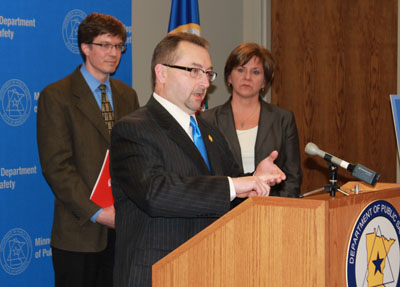Minnesota’s primary seat belt law resulted in 68 fewer deaths and 320 fewer severe injuries from 2009 to 2011, according to a study released March 26 by the Minnesota Department of Public Safety’s Office of Traffic Safety.
The study, conducted by the University of Minnesota’s Center for Excellence in Rural Safety on behalf of DPS, also found that the reduction in deaths and injuries has resulted in $45 million in avoided hospital charges, including nearly $10 million in taxpayer dollars that would have paid for Medicare and Medicaid charges.
“As Minnesota continues its efforts to move roadway deaths towards zero, this research shows that seat belts are a critical tool in that effort,” said Commissioner Tom Sorel. “There are many people alive today, in Minnesota as well as across the country, thanks to seat belts.”

Commissioner Tom Sorel discusses findings of a study on seat belt use at a news conference March 26. Sorel joined Frank Douma, University of Minnesota Humphrey Institute, and Mona Dohman, Department of Public Safety commissioner, at the news conference. Photo by Kevin Gutknecht |
Minnesota’s primary seat belt law went into effect in June 2009. Prior to that, not wearing a seat belt was a secondary offense, which allowed law enforcement officers to ticket for failure to wear seat belts, but only when there was another moving violation.
Under the primary seat belt law, officers can ticket drivers for not wearing a seat belt without any other law being broken. Currently, 32 states have primary seat belt laws.
CERS analyzed the impacts of the new law, examining the changes in roadway crash fatalities through June 2011. CERS also examined seat belt use data and survey results that measured support for the law and found:
- More Minnesotans are buckling up since the primary law went into effect—seat belt use in the state has increased from 87 percent in 2008 to 93 percent in 2011.
- Minnesotans’ support of the law increased from 62 percent just before the law was passed to more than 70 percent since it was passed.
Seat belt use is an integral part of the Toward Zero Deaths initiative—a multiagency effort focused on advancing traffic safety and preventing deaths and injuries on Minnesota’s roads through education, enforcement, engineering and emergency trauma response.
TZD uses increased enforcement targeting seat belt use, speeding and impaired driving; paid media and outreach efforts to educate communities; MnDOT engineering enhancements; and improved emergency medical and trauma response that increases the chances of survival for crash victims, especially in rural communities.
Minnesota traffic deaths have decreased in the last few years as a result of TZD and other traffic safety initiatives, according to DPS. Traffic fatalities in the state are down nearly 40 percent from a decade ago; 2011 marks the first year the state will be under 400 annual deaths since 1944. |



